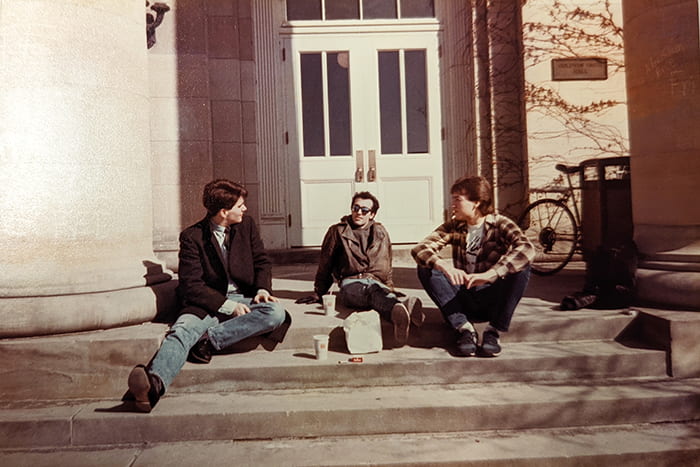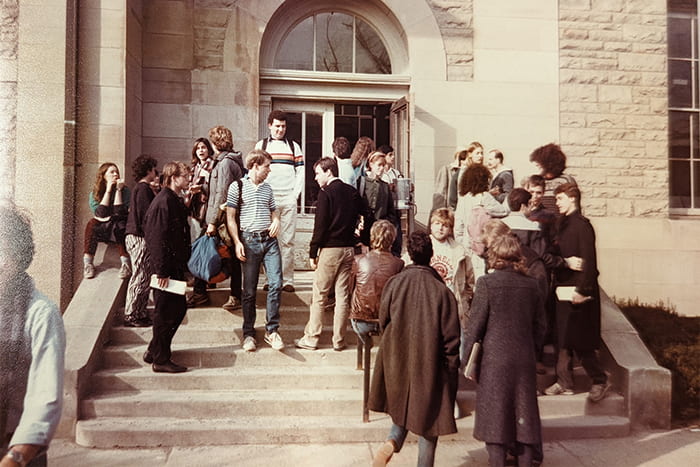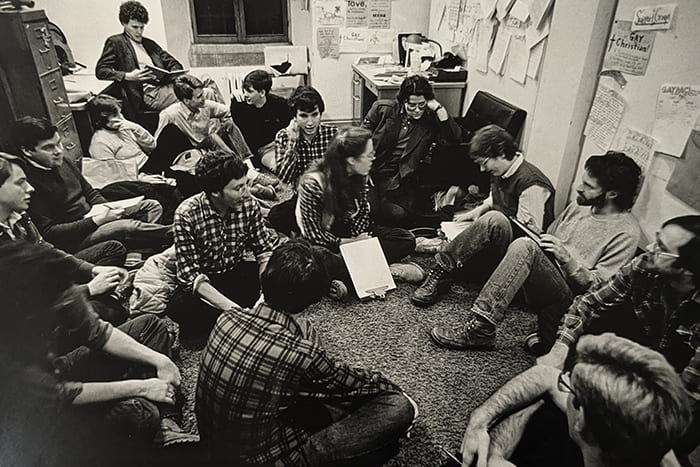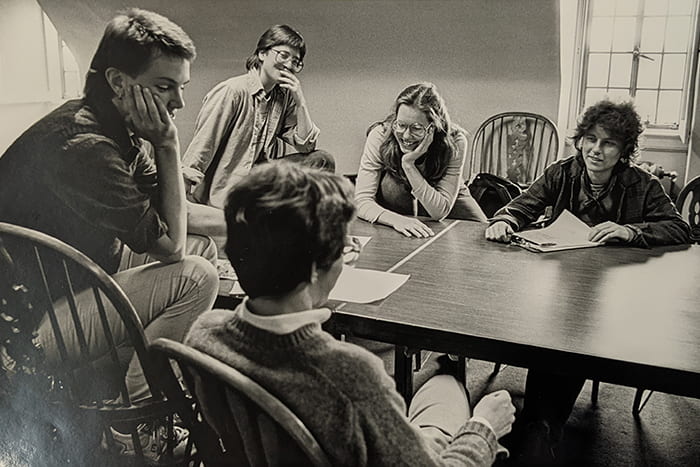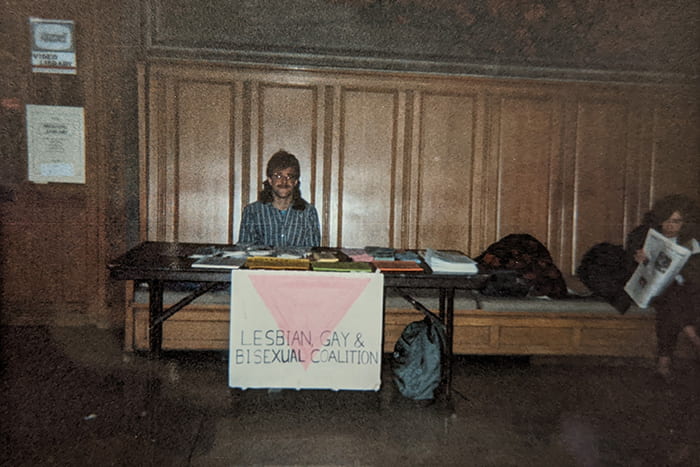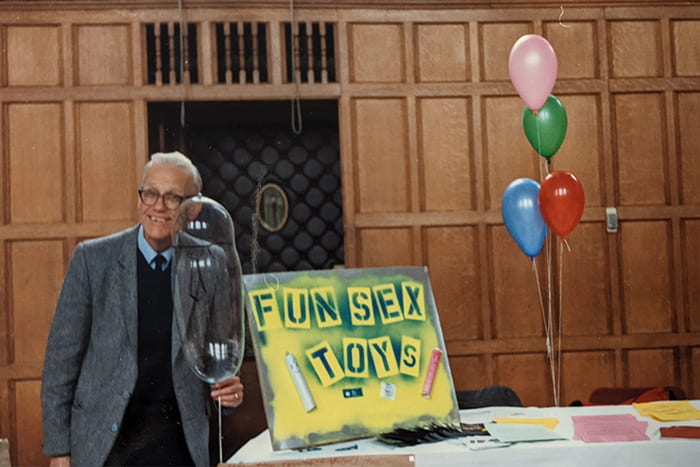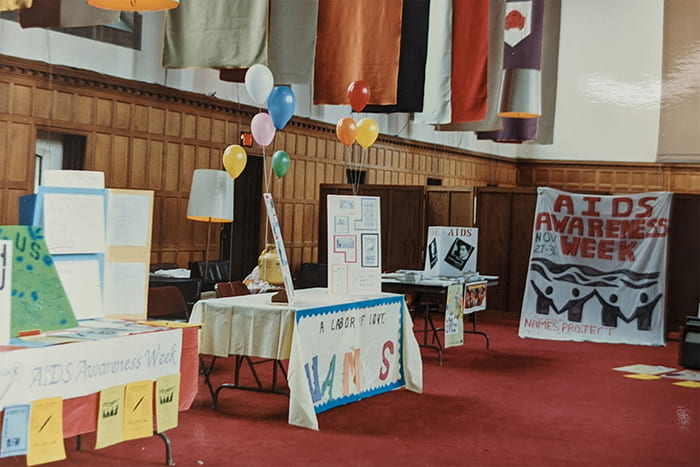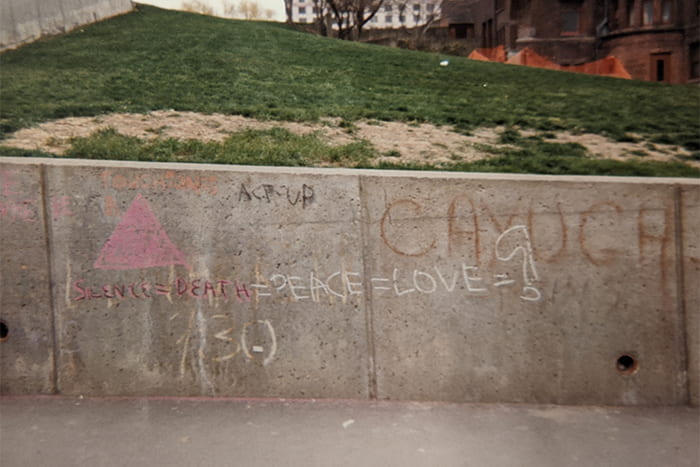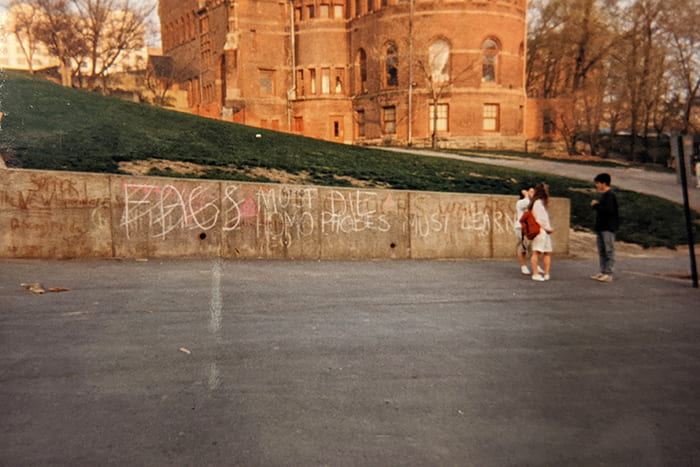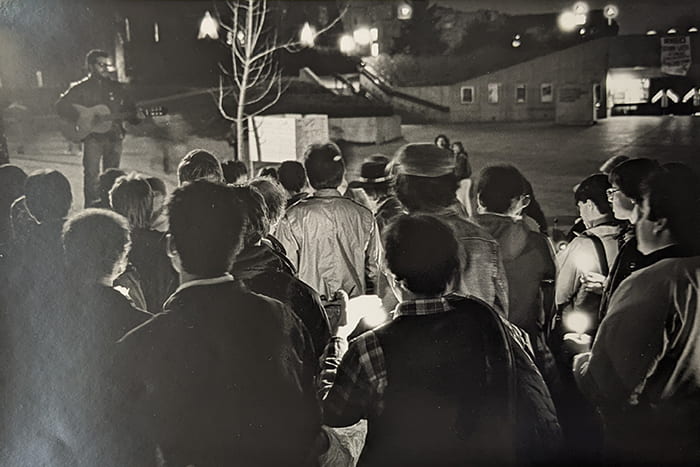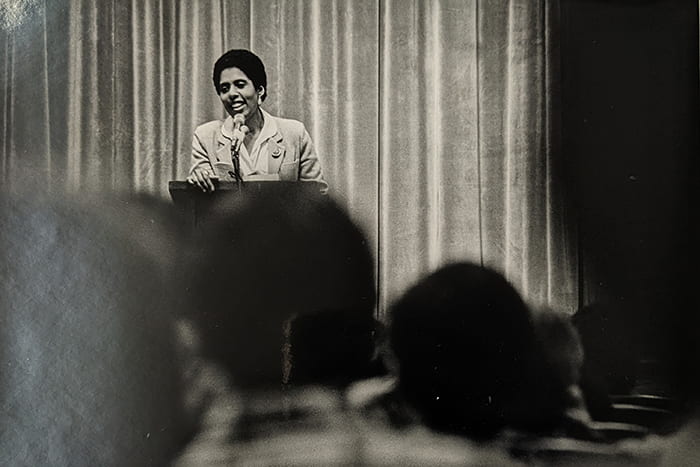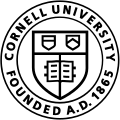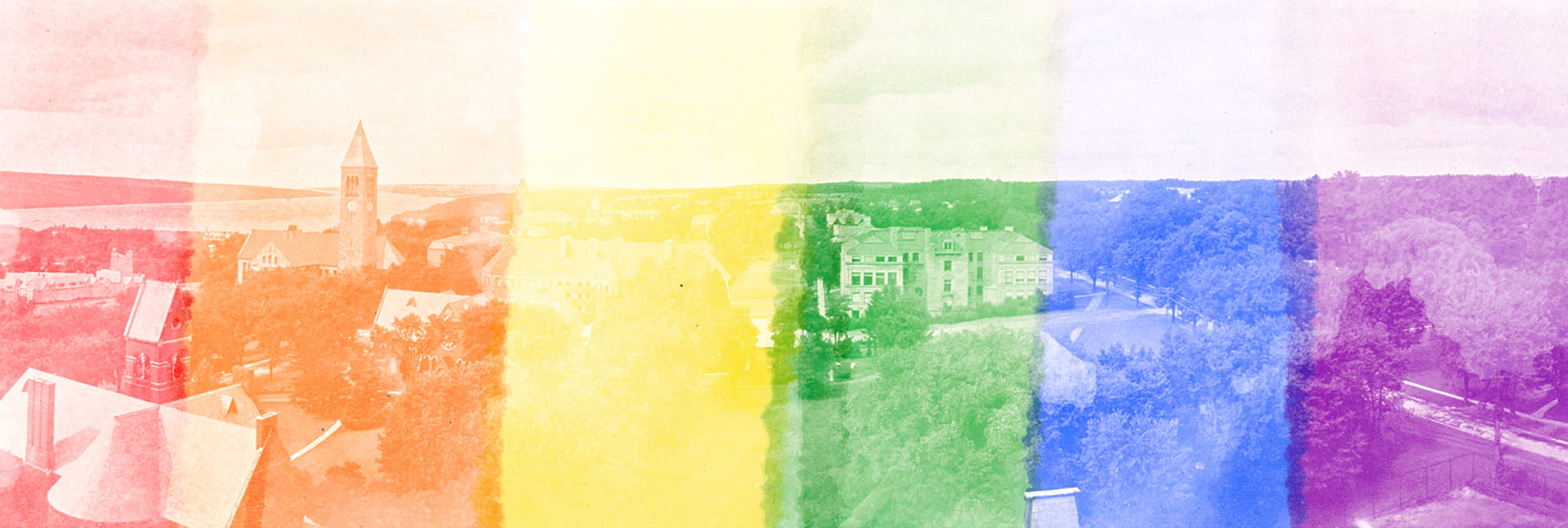
Queer Presence at Cornell, 1960’s-1990’s
Bella Somoza ’22
I hope Cornell’s queer students find echoes of themselves in the past when they look at these photos.
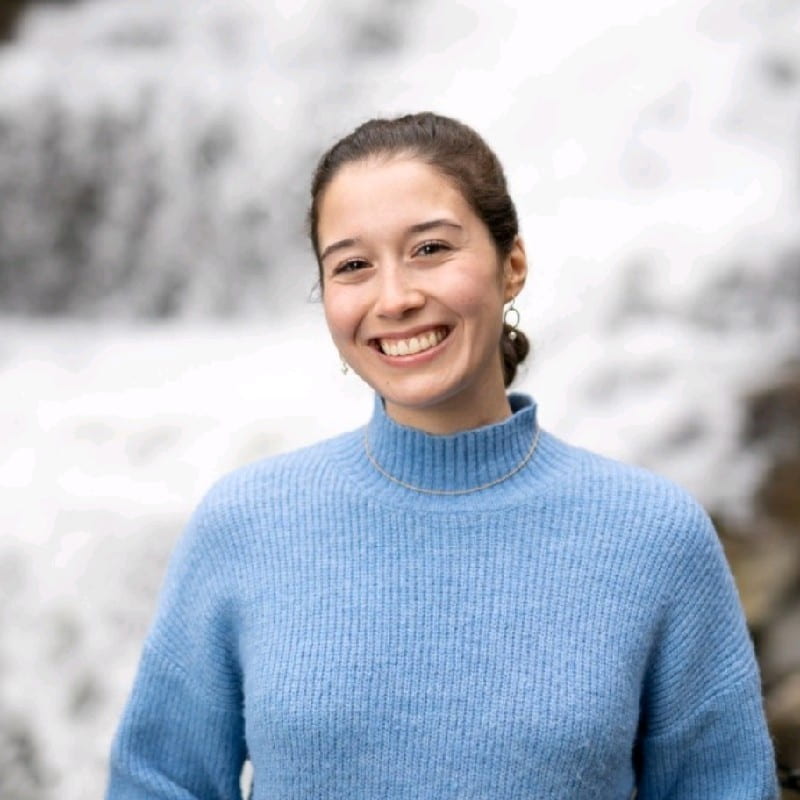
The goal of this project is to bring to light an often-overlooked story: that of queer students on Cornell University’s campus. Throughout history LGBTQ+ students, especially queer students of color, have been left out of the narrative of Cornell’s history. Even in the course AMST 2001: History of Cornell, their contributions to campus are not mentioned. The university has an incredible archive of queer history at Cornell, and I hope this project inspires people to explore this story more. Queer students struggle to find their place on this campus today, but queer students have always been here and have carved out space for themselves on this relatively heteronormative campus since at least 1968, when the Student Homophile League was founded (the second queer club to be founded at any university in the nation).[1] I want to challenge the notion of what a queer space looks like by pointing out buildings that contemporary students pass every day without considering their history. I hope Cornell’s queer students find echoes of themselves in the past when they look at these photos.
Note: Photo references are listed at end.
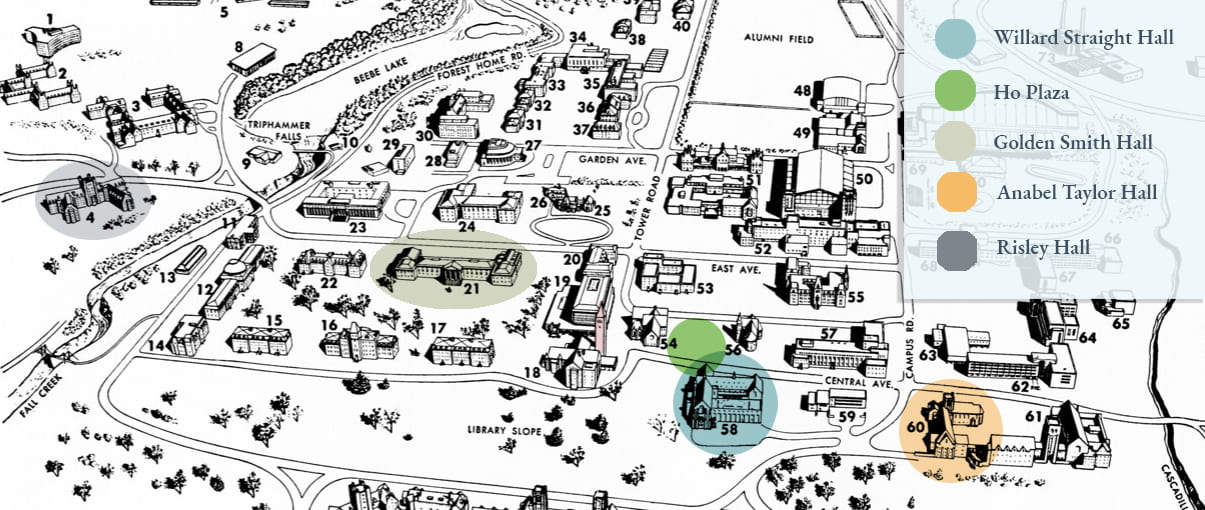
Cornell University. (1962). Map of the Cornell University campus. Ithaca, NY: Cornell University Library, Division of Rare & Manuscript Collections. University Archives. https://digital.library.cornell.edu/catalog/ss:544498

Goldwin Smith Hall

This bathroom is being monitored.
The first mention of gay students at Cornell in the archive is in an anonymous 1966 Cornell Daily Sun article, “Unwanted Compassion.”[2] The authors ask the Cornell community to reflect on their views of homosexuality. They want heterosexual people to stop calling homosexuality a problem, to accept that it exists, and to admit that they do not have a say on the morality of homosexuality. The article ends by briefly mentioning a sign outside the men’s bathroom in Goldwin Smith Hall that read “this bathroom is being monitored.” This sign referred to male students monitoring the bathroom for homosexual behaviors, for example, oral sex between queer men. The bathroom had an unspoken reputation for being a place for queer men to meet and engage in sexual activity.[3] The men’s bathroom in Goldwin Smith Hall is just one example of how queer students made space for themselves on a heterosexually-dominated campus. These photos reveal that Goldwin Smith Hall remained a queer space for students in the following decades.
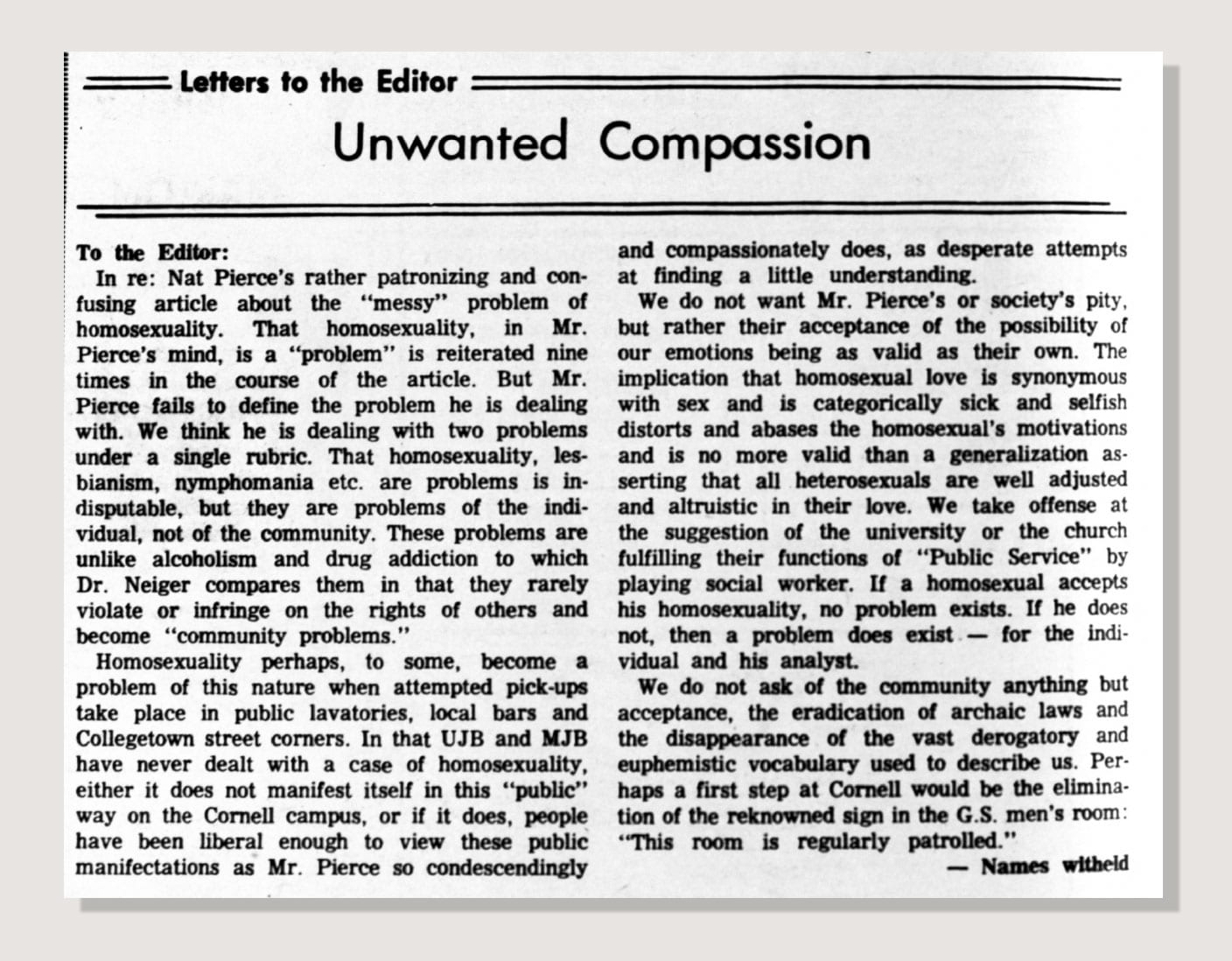
1966 Cornell Daily Sun letter to the editor, “Unwanted Compassion”
1966 Cornell Daily Sun letter to the editor, “Unwanted Compassion”
These photos reveal that Goldwin Smith Hall remained a queer space for students in the following decades.

Willard Straight Hall
Today we associate LGBTQ+ clubs like Haven and the LGBT Resource Center with being off campus or out of the way. In the past, LGBTQ+ organizations were directly in the center of campus, at the heart of student life in Willard Straight Hall. As you can see in the next photos, Willard Straight Hall was a hub of social events, meetings, and activism. LGBTQ+ students and their allies celebrated their identity here, organized club events, and staged activist events. As a central location for many students, it was a popular site for educational opportunities. Willard Straight Hall was home to the Gay People at Cornell (GAYPac) and Gay Liberation Front (GLF) office from 1969-1972, when it moved to Sheldon Court.[4] The music room inside the building was one of the earliest mentioned queer spaces in Cornell’s University Archives. Queer students would gather there to escape from mainstream, heteronormative society, and take pride in their identity as outsiders. As Jearld Moldehaur reflects, it was the place to go for those who did not fit into mainstream Greek life, which included many queer students.[5]
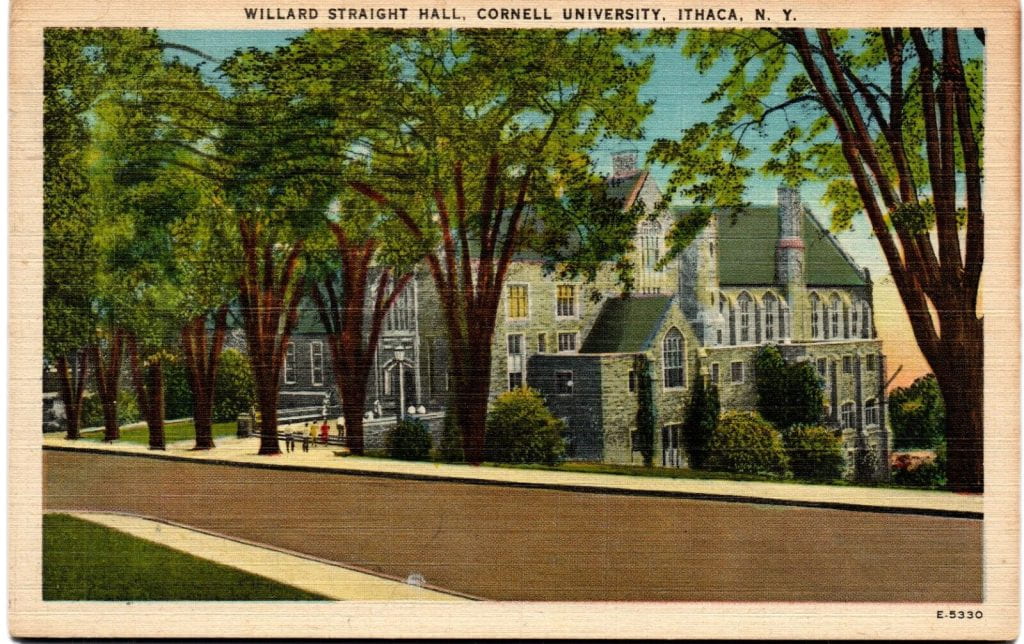
It was the place to go for those who did not fit into mainstream Greek life, which included many queer students.
Jearld Moldehaur

Ho Plaza

SILENCE = DEATH
Like Willard Straight Hall, Ho Plaza was a popular choice for activist (and homophobic) events because of its central location; students were guaranteed to pass through it on the way from their Collegetown apartments to class or to buy textbooks from the Cornell Store. These events included vigils, rallies, and protests. Before the concrete wall leading to the campus store on Ho Plaza was covered in ivy and posters, it was often graffitied by students. In the late 80s, at the height of the AIDS epidemic, the wall was often covered in homophobic slurs. Instead of erasing the graffiti, queer students directly interacted with it by crossing it out and rephrasing it. On April 15, 1990, the LGB Coalition held a “take back the wall” event as part of LGBT awareness. Members graffitied the wall with activist messages like “silence=death,” the ACT UP slogan. Queer students reclaimed the wall to fight for their right to be treated as equals.

Anabel Taylor Hall
During the 1980s, the Lesbian and Gay Discussion and Action Group (LAGPAD) hosted several events in Anabel Taylor Hall for their members. The goal of these events was to have fun, celebrate their pride in their identities, and facilitate opportunities for queer students to get to know each other. Coffeehouse events were hosted once a month.[6] Today, Anabel Taylor Hall is often the chosen venue for political speakers who come to campus because of its proximity to the Law School. This was true in the 1980s, when controversial LGBTQ+ speakers were invited to give talks to the Cornell community.

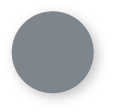
Risley Hall
Now the home to the annual Rocky Horror Picture show, a widely celebrated event in the queer community, Risley Hall was once a popular formal gathering place for queer students. Several dances were held in Risley Hall, where queer students from Cornell University and Ithaca College were invited to socialize and have fun.[7]
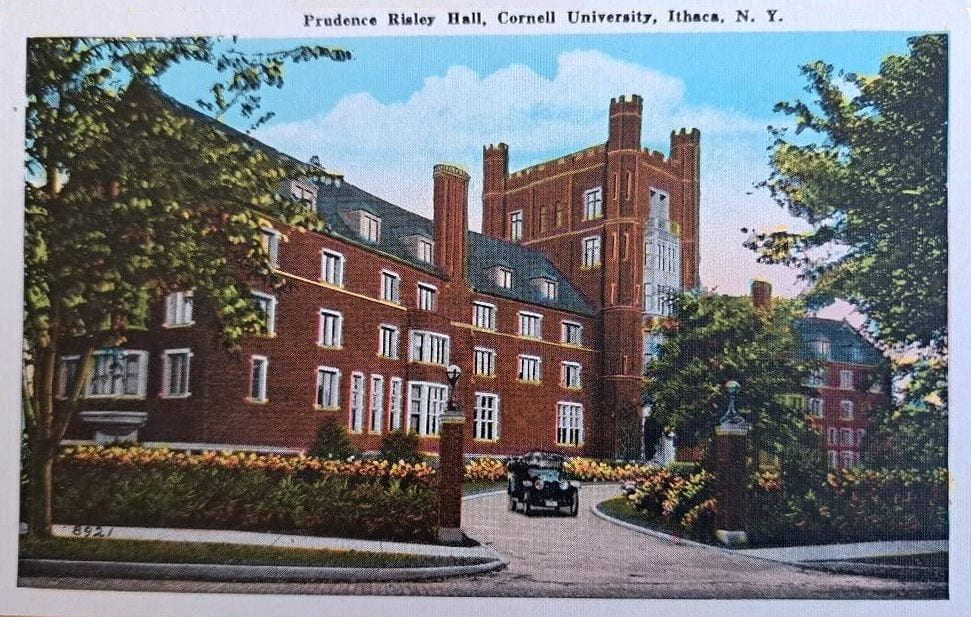

Credit: David Reuther, 1984

I want to acknowledge that the information presented here predominantly focuses on white gay men, and leaves little space for those of other identities, like queer women and people of color. I was originally inspired to do this project after reading Dr. Samantha Rosenthal’s article “Make Roanoke Queer Again.” Her comments on white gay male dominance in queer archives resonated deeply with me, especially her words that “patriarchy reigns within queer public history.”[8] Although we have a long way to go until all voices are represented equally, I believe even these dominant stories need to be told. We can learn a lot from them. As Dr. Rosenthal writes, “in order to bring out the voices of queer women and transgender individuals, we have been forced to read against the grain of the dominantly white gay male archive that we have established in order to rescue these lost voices.”[9] Despite the dominance of white gay men in Cornell’s queer history, I hope readers of this article can find those lost voices in the images shared here. To the readers: I promise you that queer women, people of color, and transgender individuals have always existed at Cornell, even if they were often overshadowed. You just have to read between the lines.[10]
To the readers: I promise you that queer women, people of color, and transgender individuals have always existed at Cornell, even if they were often overshadowed. You just have to read between the lines.
Bella Somoza
Acknowledgements
A huge thank you to Professor Stephen Vider for inspiring this project! It’s only because of his class, HIST 2335: Making Queer History Public, that I discovered these photos. He taught me how to properly conduct archival research, and opened my eyes to what Cornell’s amazing archives have to offer. His passion for public history allowed me to engage with queer history in a way I (and many others) have never had the opportunity to. He is truly one of the best teachers I have ever had! Thank you to my classmates for finding some of the photos I used in this project; particularly, I never would’ve found the Biology and Society 451 AIDS Awareness Week Photos without them. Finally, thank you to Brenda Marston in the Rare and Manuscript Collections for her incredible patience; her kindness in helping me locate materials; and finally, her excitement for bringing queer and sexual history to the public. Thank you for helping me queer Cornell’s campus.
Photo References
Goldwin Smith Hall
Photo 1: Haftan Eckholdt interview with Jearld Moldenhauer, November 21, 1989, Cornell LGBT Coalition Record. Haftan M. Eckholdt papers, #7622. Division of Rare and Manuscript Collections, Cornell University Library.
Photo 2 & 3: Photographs of Events and Meetings. Cornell Lesbian, Gay, Bisexual, and Transgender Coalition records, 1967-1999, Box 6. Human Sexuality Collection, Rare and Manuscript Collections. Cornell University Libraries.
Willard Straight Hall
Photo 1, 2, 3: Photographs of Events and Meetings. Cornell Lesbian, Gay, Bisexual, and Transgender Coalition records, 1967-1999, Box 6. Human Sexuality Collection, Rare and Manuscript Collections. Cornell University Libraries.
Photo 4: Ruether, David. “A business meeting in the GayPAC office in Willard Straight Hall. These meetings are held every Thursday to plan discussion topics and future group activities, vote on issues and policies, and are open to the public.” 1984. Photograph. 37-6-1589, Box 6. Cornell Lesbian, Gay, Bisexual and Transgender Coalition Records. Division of Rare and Manuscripts Collections, Cornell University Library, Ithaca, NY.
Photo 5: Ruether, David. “A meeting of Cornelllesbians in Willard Straight Hall, May 1, 1984.” 1984. Photograph. 37-6-1589, Box 6. Cornell Lesbian, Gay, Bisexual and Transgender Coalition Records. Division of Rare and Manuscripts Collections, Cornell University Library, Ithaca, NY.
Photo 6: “A Zap training session held in Willard Straight Hall, February 11th, 1984. Four people from a roster of trained ‘Zappers’ go on request as a panel before classes, service organizations, churches, dormitory groups, faculty, fraternities, and anyone else who requests a Zap. The ‘Zappers’ serve to foster understanding of gay and lesbian people in the straight community.” 1984. Photograph. 37-6-1589, Box 6. Cornell Lesbian, Gay, Bisexual and Transgender Coalition Records. Division of Rare and Manuscripts Collections, Cornell University Library, Ithaca, NY.
Photo 7: “A brown-bag lunch with Vito Russo, author of The Celluloid Closet. Willard Straight Hall, March 6th, 1984.” 1984. Photograph. 37-6-1589, Box 6. Cornell Lesbian, Gay, Bisexual and Transgender Coalition Records. Division of Rare and Manuscripts Collections, Cornell University Library, Ithaca, NY.
Photo 8: Willard Straight Hall LGBT Coalition table. Photograph. 37-6-1589, Box 6. Cornell Lesbian, Gay, Bisexual and Transgender Coalition Records. Division of Rare and Manuscripts Collections, Cornell University Library, Ithaca, NY.
Photo 9 & 10: “AIDS and Society” scrapbooks, Cornell Biology and Society 451 records, 1989-1992, 21-44-3298, Box 1. Human Sexuality Collection, Division of Rare and Manuscript Collections. Cornell University Libraries.
Photo 11: Ruether, David. “An evening discussion group in Willard Straight Hall. Such discussions are held weekly during the school year. Anyone who wishes to attend is welcome and discussion topics are generally advertised in advance.” 1984. Photograph. 37-6-1589, Box 6. Cornell Lesbian, Gay, Bisexual and Transgender Coalition Records. Division of Rare and Manuscripts Collections, Cornell University Library, Ithaca, NY.
Ho Plaza
Photo 1: Norin, Troy. Take Back the Wall. April 15th, 1990. Photograph. 37-6-1589, Box 7. Cornell Lesbian, Gay, Bisexual and Transgender Coalition Records. Human Sexuality Collection, Division of Rare and Manuscripts Collections, Cornell University Library, Ithaca, NY. (Copyright 1990 Cornell Daily Sun, Inc.)
Photo 2: Take Back the Wall. April 15th, 1990. Photograph. 37-6-1589, Box 7. Cornell Lesbian, Gay, Bisexual and Transgender Coalition Records. Human Sexuality Collection, Division of Rare and Manuscripts Collections, Cornell University Library, Ithaca, NY.
Photo 3: Homophobic graffiti, Cornell Store, Ho Plaza. Photograph. 37-6-1589, Box 7. Cornell Lesbian, Gay, Bisexual and Transgender Coalition Records. Human Sexuality Collection, Division of Rare and Manuscripts Collections, Cornell University Library, Ithaca, NY.
Photo 4: Homophobic graffiti, Ho Plaza. Photograph. 37-6-1589, Box 7. Cornell Lesbian, Gay, Bisexual and Transgender Coalition Records. Human Sexuality Collection, Division of Rare and Manuscripts Collections, Cornell University Library, Ithaca, NY.
Photo 5: Ruether, David. “The second annual candlelight vigil on the steps of Willard Straight Hall, May 1, 1984 (George Ayala playing and singing).” 1984. Photograph. 37-6-1589, Box 6. Cornell Lesbian, Gay, Bisexual and Transgender Coalition Records. Division of Rare and Manuscripts Collections, Cornell University Library, Ithaca, NY.
Photo 6: National Day of Silence, Ho Plaza. Photograph. 1997.Cornell University Lesbian, Gay, Bisexual, Transgender Resource Center Records, 53-23-3192, Box 2, Folder 3. Human Sexuality Collection, Division of Rare and Manuscript Collections. Cornell University Libraries.
Anabel Taylor Hall
Photo 1: Ruether, David. “February’s Coffeehouse at Anabel Taylor Hall.” 1984. Photograph. 37-6-1589, Box 6. Cornell Lesbian, Gay, Bisexual and Transgender Coalition Records. Division of Rare and Manuscripts Collections, Cornell University Library, Ithaca, NY.
Photo 2: Ruether, David. “Barbara Smith – black feminist lesbian, editor of Home Girls – lecturing on gay oppression, February 23rd, 1984 in Anabel Taylor Hall.” 1984. Photograph. 37-6-1589, Box 6. Cornell Lesbian, Gay, Bisexual and Transgender Coalition Records. Division of Rare and Manuscripts Collections, Cornell University Library, Ithaca, NY.
Risley Hall
Photo 1: Ruether, David. “Fifteenth Anniversary Dance, Risley Dining Hall. February 16th, 1984. Several dances are held throughout the school year.” 1984. Photograph. 37-6-1589, Box 6. Cornell Lesbian, Gay, Bisexual and Transgender Coalition Records. Division of Rare and Manuscripts Collections, Cornell University Library, Ithaca, NY.
Photographer
David Ruether was an architecture student at Cornell from about 1960-1962. He returned to Cornell as a volunteer for GayPac to support the phone line. He taught briefly at Cornell and at Wells College, photography, filmmaking and electronic music. Four museums have collected his photographs: The George Eastman House, The Museum of Modern Art, The Philadelphia Museum, and the Johnson Museum. His photos are used with permission.
Notes
- Brett Beemyn, “The Silence Is Broken: A History of the First Lesbian, Gay, and Bisexual College Student Groups,” Journal of the History of Sexuality 12 (April 2003): 205, https://doi.org/10.1353/sex.2003.0075
- “Unwanted Compassion,” The Cornell Daily Sun, December 12, 1966, 4, https://cdsun.library.cornell.edu/?a=d&d=CDS19661212-01.2.19&srpos=1&e=——-en-20–1–txt-txIN-%22Unwanted+Compassion%22——
- Haftan Eckholdt interview with Jearld Moldenhauer, November 21, 1989, Cornell LGBT Coalition Record. Haftan M. Eckholdt papers, #7622. Division of Rare and Manuscript Collections, Cornell University Library.
- LGBTQ+ History at Cornell, https://scl.cornell.edu/identity-resources/lgbt-resource-center/about-lgbt-resource-center
- Jearld Moldenhauer, “The Cornell Student Homophile League,” Jearld Moldenhauer, last modified 2015, https://www.jearldmoldenhauer.com/wp-content/uploads/Cornell-Final5X.pdf.
- Beemyn, Brett, “The Silence Is Broken: A History of the First Lesbian, Gay, and Bisexual College Student Groups,” Journal of the History of Sexuality 12 (April 2003): 205, https://doi.org/10.1353/sex.2003.0075.
- News From GAYPAC, April/May 1984. Cornell Lesbian, Gay, Bisexual, and Transgender Coalition records, 1967-1999, Box 11, Folder 57. Human Sexuality Collection, Rare and Manuscript Collections. Cornell University Libraries.
- Rosenthal, G. Samantha. “Make Roanoke Queer Again: Community History and Urban Change in a Southern City.” The Public Historian 39, no. 1 (February 2017): 35-60. https://www.jstor.org/stable/26420962. p.52-53.
- Ibid.
- If you want more information on the voices of queer women, transgender individuals, and queer people of color, I recommend the following articles. On race: Glenn C. Altschuler and Isaac Kramnick’s “The Bureaucratic University and Its Discontents” and Ian Wilhem’s “Ripples from a Protest Past” in the Chronicle of Higher Education (2016). On the intersection of queerness and race: George Ayala’s “Making AIDS a Priority,” Cornell Daily Sun (May 5, 1986) and Diana Skelton’s “Gays, Lesbians of Color Rally, Discuss Oppressions, Tactics” Cornell Daily Sun (April 14th, 1986). (All of the sources mentioned in this footnote and in the article were sourced by or for Dr. Stephen Vider for his class Making Public Queer History. If you are interested in learning more, I highly suggest you take this class!)

